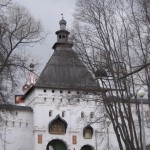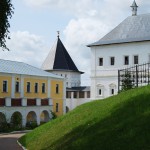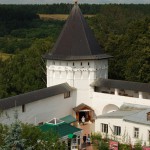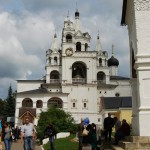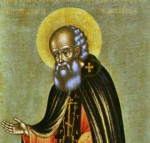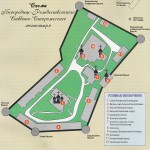Savvinskaya Sloboda and Savvino-Storozhevsky Monastery
The history of Savvinskaya Sloboda, which is situated west of Zvenigorod, is closely intertwined with the history of the Savvino-Storozhevsky Monastery. The first mention of local neighborhood dates back to 1331, when Ivan Kalita, as he was allotting an inheritance to his son Ivan the Fair, mentioned the Belzhinskoye village among other Zvenigorod settlements. It has different names in the historical sources: Beltsinskoye, Belgino, Beldino. Early in the XVII century, the village was ruined in military actions and was never recovered. There had been various opinions among historians concerning the whereabouts of the village, until in 1976 during the archeological excavations, A. A. Yushko and S. Z. Chernov managed to define its cite clearly on the outskirts of the present Savvinskaya Sloboda.
In the last will of Great Prince Ivan the Fair of 1358, together with the Belzhinskoye village a “new seltso” (little settlement) is mentioned. Later, it was called the village of Ust-Rozvadnya in the documents (by the name of the Rozvadnya River, which flows into the Moskva River) and then it is mentioned as Savvinskaya Sloboda. At the very end of XIV century, on the opposite side of the Rozvadnya (now the river bears the name Storozhka) a monastery was founded, which owes its existence to the former superior (Igumen) of the Troitse-Sergiyev monastery, whose name was Savva.
Our knowledge about this disciple of Sergius of Radonezh (Sergii Radonezhsky) is very scarce. Savva was born during the reign of Ivan Kalita, around 1327. It is not known, where he was from and whose son he was, but at young age, around 1345, he came to the monastery of Sergii Radonezhsky and became one of his earliest and most honorable disciples. Savva’s hagiography tells us that he was prominent in his spiritual wisdom, ascetic living and great humility. After taking the monastic vows around 1350, Savva was ordained into celibate priesthood and appointed as spiritual confessor of the brethren. In 1392, after Sergii Radonezhsky’s death, he was chosen as the Igumen of the Trinity (Troitsky) monastery. But he had not been heading over for too long, and around 1398 he moved to Zvenigorod at the request of Prince Yuri Dmitrievich, whose confessor he was.
Savva’s hagiography keeps silent on the true reasons of his departure from the affluent Troitsky monastery. Apparently, after the death of his teacher, Savva wanted to occupy at the court as honorable a position as that one of Sergii Radonezhsky with Dmitry Donskoy. But metropolitan Kyprian had already been playing this role with Dmitry’s son, Great Prince Vasily I, and Savva may have thought that it was more appealing to occupy an honorable position at the court of the Prince of Zvenigorod. As he settled on the Storozhevskaya Mount near Zvenigorod, Savva built a wooden church of the Nativity of the Holy Virgin there, and quite soon gathered many cenobites. To find solitude, he dug a cave, in which he spent much of his time in prayer and godly thoughts. After the successful military campaign against the Bulgars in 1399, Prince Yuri Dmitrievich presented to the monastery many lands, and among them there were the villages of Belzhinskoye and Ust-Rozvadnya; the latter was signed in to the monastery. The cloister was freed from taxes and levies, and a stone temple was built in it. Savva lived till his old age and, according to his hagiography, written by the Igumen of the Khutynsky Monastery – Markel, died on December 3 of 1406, being over 80 years old; for over sixty years of his life, he was accomplishing his monastic feat.
Under the benevolence of Prince Yuri Dmitrievich, the monastery soon became the main cloister of the Zvenigorod land, possessing great riches. All the rest of the successive feudal lords of the city, being well aware of the importance of spiritual authority, supported the cloister.
But the heyday of the monastery falls upon the XVII century – the reign of Tsar Alexis Mikhailovich. This was the period of creation of the new architectural ensemble and of the beautification of its founder – Saint Savva Storozhevsky. On January 19 of 1652, in the presence of the tsar, patriarch Joseph and Nikon, the metropolitan of Novgorod, who became ill-famed later, the incorruptible remains of Savva were solemnly uncovered.
By this time, the process of renovating the church ensemble, which had suffered during the Turmoil times, was in full progress. The restoration of the Monastery began with the reconstruction of the Nativity Cathedral, where starting since May of 1649 a group of tsar’s icon painters, which numbered 27 people, painted the main volume of the temple against the golden background, and its aisles and chancels. The core of the team under prominent icon painters Stepan Ryazantsev and Vasily Iliyn was made up of the artists, who worked in the cathedrals of the Moscow Kremlin. At the same time in Moscow, the team of painters under Karp Timofeyev was making a unique iconostas, which has been preserved till our days; its frames were done by the craftsmen of the Armory Ward. In the same year of 1649, not far from Sloboda two brick factories were founded, which produced the bricks for the monastery’s construction works. (In the Soviet times, archeologists discovered there characteristic residues and determined their location). In 1650-1652, the builders erected the monastery walls with seven towers, which caused the cloister’s territory to increase significantly. A unique ensemble was created, including the Red Tower (or the Fair Tower) with the church in honor of the tsar’s heavenly patron – St. Alexius of Rome (“Man of God”) and the Troitskaya (Trinity) Church over the gates, originally called Sergievskaya. Its high ground floor(1) is masterfully used by the builders for shaping three flights of the stairs, and the span of the walls is decorated with architectural elements in the original Russian Baroque style. The first stage of the monastery’s construction was carried out under the supervision of A. Shahov and N. Bobarykin.
Construction within the monastery walls continued for almost the entire second half of the XVII century. The buildings, laid down under Tsar Alexis (Alexey Mikhailovich) were added onto and changed their appearance under his children. The construction activity was especially bubbling in the short period of the reign of Tsarevna Sofia. Around the ancient Nativity Cathedral rose the Tsar’s palace and the Queen’s Chambers, the monks’ barracks and the refectory, the Transfiguration Church and the belfry, which had a unique collection of bells. The biggest one of them, famous for its chimes, weighing 34 tons and 12 kilograms was cast in 1668 by “the state guns and bells’ master” Alexander Grigoriev (the bell was lost in 1941). The north-east section of the monastery was occupied by some household outbuildings, while the north-west – by the infirmary wards with the church of John of the Ladder (John Climacus).
The tsar’s patronage resulted in huge land gifts to the monastery, which soon caused it to become one of the biggest spiritual land owners. The expansion of the land riches of the monastery took place through the adjoining of other, smaller cloisters to it. Alexey Mikhailovich’s children also demonstrated their care for the monastery. Under Feodor Alekseevich, the cloister was called “the tsar’s room monastery.” Tsarevna Sofia exercised special patronage over the monastery, as she found refuge behind its walls during the Streltsy Uprising in 1682.
Changes in the monastery’s life reflected on the Sloboda as well. According to the description of 1624, there were 12 households in it, but in 1678 in the Sloboda there already were 5 minor officials’ houses, 26 households of servicemen, a horse service, 12 households of stablemen, 8 households of kitchen people and 8 households of craftsmen, 10 households of blacksmiths and 3 households of aids. All of these ones helped with the monastery facilities. Across the Rozvadnya River (Storozhka River), there was a Sloboda of Streltsys, in which there were 48 households; and on the opposite side of the Moskva River there was a little settlement (slobodka) of 38 households, which belonged to the monastery. According to the record of 1705, in that slobodka there were 130 households of people of different ranks and 10 empty houses of contributed soldiers. At the monastery there were stables, trading and gardening services.
In the XVIII century, the monastery lost its former role. In the years of Peter I reforms, it remained only as a nominal owner of large land resources virtually controlled by the government. The picture of the monastery’s decline was vividly illustrated by the current archimandrite Silvester, “in the previous years… the holy cloister was rich in all ways, but now it is devastated and impoverished, clearly falling into decay; and we suffer because of poverty, fade out of starvation, and our very holy abode itself because of its many roof leaks weeps with us unceasingly, seeing its desolation, for its facilities all dilapidated, roofs and vaults are crumbling down, and we have no means to build anything…”
By the middle of the XVIII century, greatly dilapidated monastery buildings required urgent repair work. After one of the fires, the Tsar’s Palace stood without a roof for many years. The monastery’s treasury was empty and trying to find some way out, the abode’s authorities decided to impose additional taxes on the monastery’s peasants. It issued in the peasants’ uprisings, which continued until the late fall of 1760, culminating in the peasants clash with a military brigade sent from Moscow at the Tyritzin meadow near the monastery; it was dubbed in the documents a “perfect battle.” Only in December, after the new soldiers were sent here and the peasants were informed that the military brigade would live at their expense, the turmoil ceased.
In the second half of the XVIII century, the remodeling process and reconstruction works began. It was aided by the fact that empresses Elizabeth and Catherine the Great visited the monastery twice. In 1764, all the land property of the monastery was secularized, and it was ranked with the monasteries of the first class. There is a description of the monastery as of 1800. Savva’s relics were resting in a silver reliquary in the Holy Nativity Church. Near the Church of Transfiguration there was a belfry with a clock and set of bells. The three-storey edifice near the belfry was occupied by a storehouse and a seminary. The third church devoted to Sergii Radonezhsky was adjoined by the Superior’s house; near it there was the brethren’s building, where the monks lived. Together with the Superior there were 31 of them. In the auxiliary edifices there were a candle shop, the treasury, the victuals storehouse and the wafers shop. The blacksmith’s shop stood separately. Outside the monastery there were the stables, where the rooms for guests were arranged. In the monastery village there were 84 households, in which 207 males and 246 females lived.
During the war of 1812, from August 31 till October 15, the twenty-thousand corps of the Italian kingdom Viceroy Eugene Beauharnais was stationed in the monastery, causing much damage to it. In the middle of the XIX century, there were already 109 households, where over 600 people lived. Every year, two fairs were held here – on the tenth Friday after Easter and on July the 8th.
In the second half of the XIX century, the village with its extremely scenic vicinities became an attraction for artists. It is enough to mention just some of the names of those who lived and worked here – K. Savrasov, Korovin brothers, I. Levitan. The October Revolution brought many changes into the life of this neighborhood. The monastery was closed, and a museum was accommodated in its facilities. Rest houses were opened nearby. According to the 1926 census, there were 158 households in Savvinskaya Sloboda, where 768 people lived; it had its own local administrative council, a school of the first level and two rest houses (one was of the People’s Commissariat of Communication and the other one was named after A. I. Rykov).
Now, Savvinskaya Sloboda is one of the most attractive places of rest near Zvenigorod. Thousands of tourists visit the complex of the Savvino Monastery annually. According to the 1989 census, there are 312 households in the village, and 927 people reside in it permanently.
(1)Podklet (ground floor) – is the lower part of an izba, a wooden log house, the lowest level of the two-section izba; the servants’, “black,” or “working” lower izba, sometimes uninhabited, used as a pantry; under-izbitza; sometimes the podklet was turned into a barn in wintertime, for small livestock. Usually, the nuptial bed was laid for the newly weds in the podklet, that is why it is called the podklet, no matter where it is arranged; for example, on the other half of the izba, or in a special klet. The podkletetz or podkletka is the same thing. Podklet dwelling. Podklet villages, as an obsolete synonym for royal, tsar’s villages.
The Explanatory Dictionary of Dahl. V. I. Dahl. 1863-1866.

